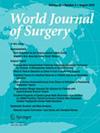Shouldice versus Lichtenstein inguinal hernia repair: A meta-analysis of randomized controlled trials.
IF 2.3
3区 医学
Q2 SURGERY
引用次数: 0
Abstract
BACKGROUND The Lichtenstein technique is the standard treatment for adult open inguinal hernia repair. Among the non-mesh repair techniques, Shouldice has shown the best results and is comparable to mesh repairs in selected cases. Due to the risk of chronic groin pain associated with the Lichtenstein technique, Shouldice has increased in popularity, and some surgeons have adopted it as a viable first-line option. METHODS MEDLINE, Cochrane, Central Register of Clinical Trials, and EMBASE for randomized controlled trials (RCT) published until February 2024. Risk ratios (RRs) with 95% confidence intervals (CIs) were pooled using a random-effects model. Heterogeneity was assessed using the Cochran Q test and I2 statistics with p-values <0.10 and I2 > 25% considered significant. Statistical analysis was performed using R Software, version 4.1.2. RESULTS Fourteen RCTs comprising 2784 patients were included, of whom 1379 (47.5%) were submitted to the Shouldice hernia repair and 1513 (52.5%) to the Lichtenstein technique. Shouldice was associated with a significant increase in the recurrence rate (4.2% vs. 0.9%; RR 3.68; 95% CI 2.05-6.60; p < 0.001; I2 = 0%) compared with Lichtenstein. The number needed to treat (NNT) to prevent one Shouldice recurrence was 30.3. There were no significant differences between groups in chronic pain, urinary retention, bladder injury, testicular atrophy, wound infection, hematoma-seroma, or hypesthesia. CONCLUSION The Lichtenstein technique was associated with reduced recurrence rates compared with Shouldice in patients undergoing inguinal hernia repair. However, the overall recurrence rate with the Shouldice technique was still low (4.2%), suggesting that it may be a viable option in selected patients.Shouldice 与 Lichtenstein 腹股沟疝修补术:随机对照试验荟萃分析。
背景Lichtenstein 技术是成人腹股沟疝开放性修补术的标准疗法。在无网片修补术中,Shouldice 效果最好,在特定病例中可与网片修补术相媲美。由于 Lichtenstein 技术有导致慢性腹股沟疼痛的风险,因此 Shouldice 越来越受欢迎,一些外科医生已将其作为可行的一线选择。采用随机效应模型对风险比 (RR) 和 95% 置信区间 (CI) 进行汇总。异质性采用 Cochran Q 检验和 I2 统计法进行评估,P 值为 25% 时视为显著。统计分析使用 4.1.2 版 R 软件进行。结果纳入了 14 项 RCT,共 2784 例患者,其中 1379 例(47.5%)采用 Shouldice 疝修补术,1513 例(52.5%)采用 Lichtenstein 技术。与Lichtenstein技术相比,Shouldice技术的复发率明显增加(4.2% vs. 0.9%; RR 3.68; 95% CI 2.05-6.60; p < 0.001; I2 = 0%)。预防一次肩周炎复发所需的治疗次数(NNT)为 30.3。各组之间在慢性疼痛、尿潴留、膀胱损伤、睾丸萎缩、伤口感染、血肿-血清肿或麻醉过度等方面没有明显差异。结论与 Shouldice 相比,Lichtenstein 技术降低了腹股沟疝修补术患者的复发率。然而,Shouldice 技术的总体复发率仍然很低(4.2%),这表明它可能是某些患者的可行选择。
本文章由计算机程序翻译,如有差异,请以英文原文为准。
求助全文
约1分钟内获得全文
求助全文
来源期刊

World Journal of Surgery
医学-外科
CiteScore
5.10
自引率
3.80%
发文量
460
审稿时长
3 months
期刊介绍:
World Journal of Surgery is the official publication of the International Society of Surgery/Societe Internationale de Chirurgie (iss-sic.com). Under the editorship of Dr. Julie Ann Sosa, World Journal of Surgery provides an in-depth, international forum for the most authoritative information on major clinical problems in the fields of clinical and experimental surgery, surgical education, and socioeconomic aspects of surgical care. Contributions are reviewed and selected by a group of distinguished surgeons from across the world who make up the Editorial Board.
 求助内容:
求助内容: 应助结果提醒方式:
应助结果提醒方式:


